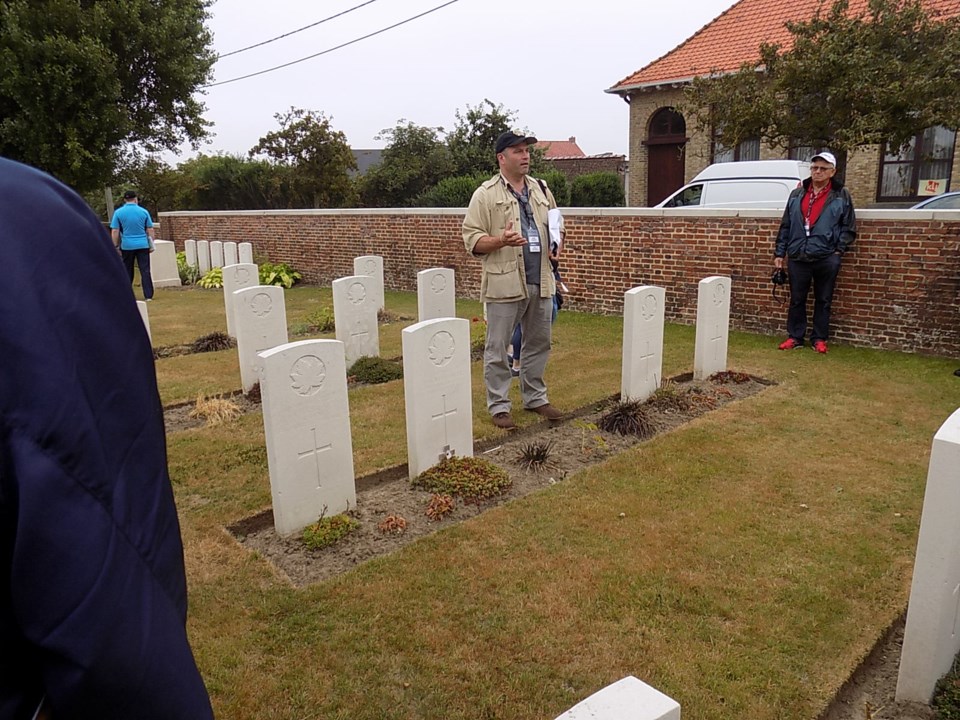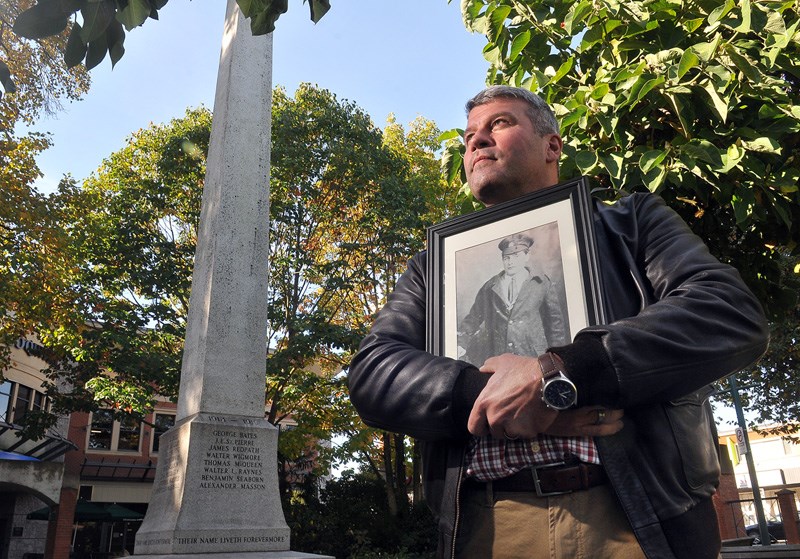There’s a quaint cemetery in Wanquentin, a bucolic village tucked into the northwest corner of France near the Belgium border and not far from the English Channel.
The last graves in the cemetery are in Plot II, Row E. Buried there, side-by-side, are 23 men from the Third Canadian Machine Gun Battalion. They had been billeted in a home in the area when they were killed during a German bombing raid on a nearby train station on Sept. 24, 1918. It was less than seven weeks from the end of what was called, a century ago, the Great War. One headstone in Row E bears the name of Charles Goheen.
“When you see your own name on a headstone, that gets you. That’s hard,” says Port Coquitlam’s John Goheen of his great-grandfather’s youngest brother as he sits in the shadow of Port Coquitlam’s cenotaph on an idyllic autumn morning 100 years later.
The sunny setting is a long way, a long time and a long distance in circumstances from the First World War. It was an ugly, brutal, bloody four-year conflict that claimed more than 15 million lives, nearly 67,000 of them Canadians, and left tens of millions more wounded. Its conclusion at the 11th hour of the 11th day of the 11th month — Nov. 11, 1918 — inspired Remembrance Day. On the 100th anniversary of the Great War’s end, Goheen will lay a wreath on behalf of all Canadians at the nationally televised Remembrance Day ceremony from Ottawa.
The Royal Canadian Legion chose the 32-year member of the organization, he says modestly, because of the extensive research he continues to do on both world wars, the work he’s done for the Legion (he leads its biannual Pilgrimage of Remembrance group trip to Europe), and the family he has lost.
“I was quite humbled, actually,” says Goheen of the invitation. “I immediately thought, because it was for someone with a personal connection, thought of my grandfather and other relatives. We had two that didn’t come home. My grandfather came home and he was never the same. So it was an immediate personal thought, then followed by being quite overwhelmed because of the magnitude of it all.”

The genesis of his passion came when his father took him to a Remembrance Day ceremony at Victory Square in Vancouver in the early 1970s when he was about seven. In attendance were veterans of the Great War.
“They seemed ancient at the time,” recalls Goheen, principal of Rochester elementary in Coquitlam. “They were just in their late 60s and 70s, but to a little kid they looked old.
“I was struck by them, and I remember coming home and wanting to know about them. I was a serious little kid who started to read and learn things, probably a touch of OCD as well, I took this idea where I wanted to know everything about something, and the next thing I know I’ve amassed a library. I just started researching like crazy.”
Along with all the war stories Goheen discovered that although he’s not from a military family, both sides are connected to the wars. Charles Goheen, had a cousin, Walter Goheen, who survived three years on the western front only to die Oct. 1, 1918 when his unit got caught in machine gun fire on its last mission and his body was lost. Walter William Goheen’s name is listed as one of the missing on the Vimy Ridge memorial.
Goheen’s maternal grandfather, Francis Niles, joined the Canadian First World War forces three weeks after he turned 17, telling recruiters he was 18. His actual 18th birthday, March 16, 1916, was the day he entered the front lines in Belguim. A little less than three weeks later, April 1, enemy fire took out about a four-inch chunk out of the back of his leg. His war was over.
Niles’s brother Robert was also conscripted in 1918 but contracted a venereal disease in London. He had recovered by the time the war ended and was seconded to the war graves commission to recover bodies on the western front.
Robert’s son, also named Robert, was killed in the Second World War on June 17, 1944 when the plane he was on returning from a bombing mission was attacked by a night fighter and crashed into the North Sea.
Goheen’s paternal grandfather, Raymond Goheen, fought in the Second World War.
His research drove Goheen to join the Legion when he was 19 where he got to know a few veterans from both wars.
“I kept my mouth shut and used my ears. They’re very guarded, typically, but once they know you’re not a threat and don’t want anything, they started to include me. They start telling you real stories about the things that happened to them that you usually don’t share. I became close to a number of them,” says Goheen.
In 1992, for the 75th anniversary of the Battle of Vimy Ridge, he tracked down three Great War veterans.
“I treasure those moments. It was really a unique experience. I was mindful then that this was not going to happen much longer, that these guys were slipping fast,” says Goheen.
In his opinion the First World War gets lost in the monstrous shadow cast by Adolf Hitler that followed.
“It was a major event in this country, and yet a couple of [decades] later when the Second World War becomes much of the focus, the Great War just sort of took a backseat,” says Goheen. “It really stayed that way into the ’60s when historians started looking back at The Great War, but it was with a certain angle. Great War poetry became well-known. It was much about the irony of The Great War, the tragedy of The Great War, the innocents being led to the slaughter.”
However, in the last 10 years, he says, the approach has changed to viewing the Great War having a cause and a purpose. The role of Canadians was instrumental, especially for a country of only 7.5 million people that went from having no real military to speak of to being “pretty much the best” from 1917 onward. For example, he points out, Canada lost 20% of its casualties during the last three months as it launched one major assault after another on the Germans. Canadian commander General Arthur Currie boasted afterward the Canadians took on one quarter of the German army and left the rest for the British and Americans.
“It is true, they took on 47 German divisions, and [Canada] had just four,” says Goheen. “They paid a huge price, but it kind of broke the Germans’ backs and allowed the allies to advance on other fronts. The Canadian contribution was huge for punching way about its weight, and it’s forgotten.”
When he leads the Pilgrimages of Remembrance he makes a point of reading every inscription on every headstone.
“I try to remember they meant something to somebody, and now with 100 years gone now, I’m often struck that maybe no one’s visited a grave,” says Goheen, who assigns the tour’s participants one soldier each to introduce at their gravesite. “Just trying to voice the name again is quite powerful.
“There’s an intimacy about them that you realize where you’re standing [in the fields of France and Belguim] so much horror happened. And you also realize where you’re standing is a graveyard. The missing are still out there, and they’re still finding them every year. When they do roadwork and construction they’re finding remains. Our group has come across remains over there. It’s gruesome.
“In Belguim alone there’s about 40,000 missing, and that’s a small area. They’re still there.”
So while he’ll be thinking of his relatives when he does the honours on Remembrance Day, he won’t forget all the others either. “The wreath is to represent all those killed in The Great War, so while it’s a personal part of it for me, it’s also cognizant it’s for all of them.”
When he returns, Goheen will continue to tell the war stories he’s discovered and to search for more with the hope lessons will be learned.
“That’s the whole point of education about these matters, that anyone who looks at it realizes there’s no glory in it at all, there’s vile things that humans can do. Veterans are the first persons to tell you there’s no glory in it,” says Goheen. “It’s about understanding what had happened, the huge sacrifices made and that freedom and peace come at a huge price.”



